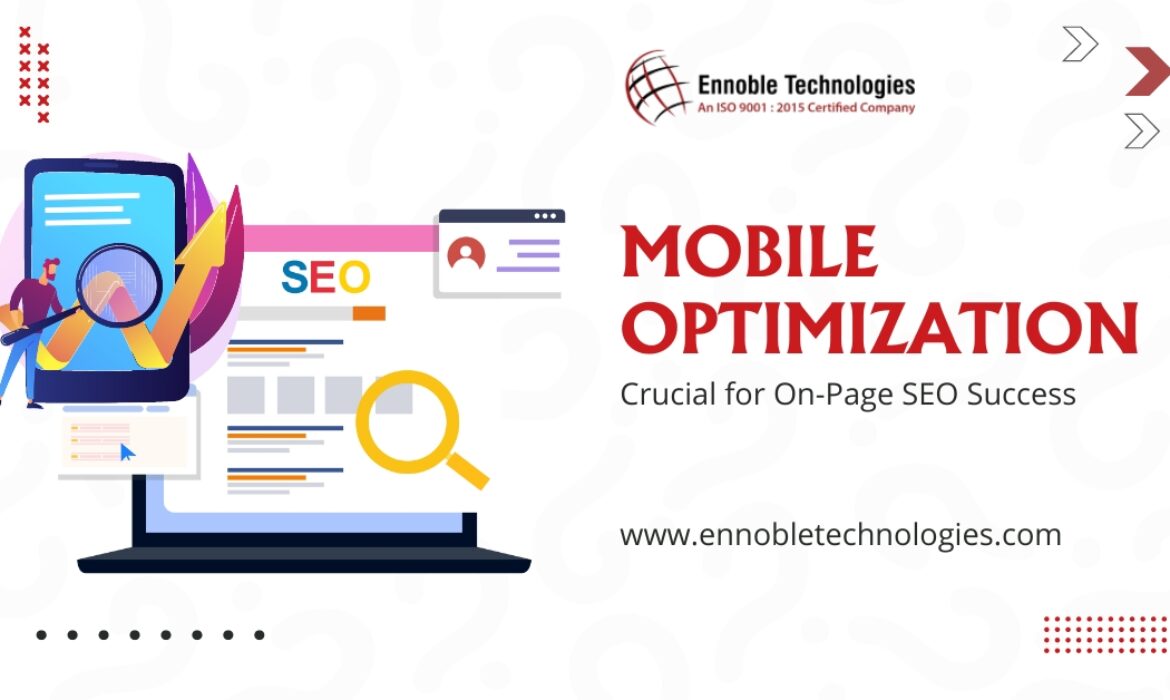Mobile Optimization: Crucial for On-Page SEO Success
In the fast-evolving landscape of digital marketing, staying ahead of the curve is not just a choice; it’s a necessity. As the majority of online users transition to mobile devices, the significance of mobile optimization cannot be overstated. This article delves into the intricate realm of Mobile Optimization and its pivotal role in achieving on-page SEO success.
I. Introduction
A. Definition of Mobile Optimization
Mobile Optimization refers to the process of ensuring that a website functions seamlessly and offers an optimal user experience on mobile devices. This involves responsive design, efficient loading times, and content adaptation to cater to the diverse array of mobile screens.
B. Significance of Mobile Optimization in On-Page SEO
The relationship between Mobile Optimization and on-page SEO is symbiotic. Google’s algorithms increasingly prioritize mobile-friendly websites, making it imperative for businesses and website owners to prioritize mobile optimization efforts.
C. Evolution of Mobile Usage and Its Impact on SEO
The surge in mobile device usage has transformed the digital landscape. From search behaviors to user expectations, understanding the evolution of mobile usage is crucial for devising effective mobile optimization strategies.
II. Importance of Mobile-Friendly Websites
A. User Experience (UX) and Mobile Responsiveness
1. Role of Responsive Design
Responsive design ensures that a website adapts to various screen sizes, providing a consistent and enjoyable user experience across devices. Its role in mobile optimization is foundational.
2. Impact on Bounce Rates
A mobile-friendly website contributes to lower bounce rates, indicating that users find the content engaging and accessible. High bounce rates may adversely affect search rankings.
B. Google’s Mobile-First Indexing
1. Understanding Mobile-First Index
Google’s Mobile-First Index prioritizes the mobile version of a website for indexing and ranking. Websites not optimized for mobile may experience a decline in search visibility.
2. How it Influences Search Rankings
Mobile-First Indexing directly impacts search rankings. Websites optimized for mobile devices are likely to rank higher, reflecting Google’s commitment to delivering mobile-friendly search results.
III. Key Elements of Mobile Optimization
A. Page Speed Optimization
1. Impact on Mobile Users
Mobile users are inherently impatient. Slow-loading pages can result in high bounce rates and diminished user satisfaction. Page speed optimization directly addresses these concerns.
2. Tools for Assessing and Improving Page Speed
Various tools, such as Google PageSpeed Insights, help assess and enhance page speed. These tools provide actionable insights to streamline website performance.
B. Mobile-Friendly Content
1. Crafting Engaging and Readable Content
Content tailored for mobile users prioritizes concise and engaging information. Short paragraphs, bullet points, and clear headings enhance readability on smaller screens.
2. The Role of Headings and Subheadings
Structuring content with well-defined headings and subheadings not only aids readability but also assists search engines in understanding the context of the content.
C. Mobile SEO Best Practices
1. Meta Tags and Descriptions
Optimizing meta tags and descriptions for mobile devices ensures that search results display relevant and concise information, encouraging users to click through.
2. Structured Data Markup for Mobile
Implementing structured data markup helps search engines comprehend the content’s structure, leading to enhanced visibility and rich snippets in mobile search results.

IV. Responsive Design vs. Mobile Apps
A. Advantages and Disadvantages of Responsive Design
1. Flexibility and Consistency
Responsive design offers flexibility by adapting to different devices, maintaining consistency in branding and user experience. However, potential drawbacks need careful consideration.
2. Mobile Apps and SEO
While mobile apps provide a dedicated user experience, optimizing them for search engines presents challenges. Balancing the advantages and disadvantages is crucial for mobile SEO success.
B. Mobile Apps and SEO
1. Enhanced User Experience
Mobile apps can deliver a tailored and immersive user experience. Capitalizing on app-specific features contributes to increased user engagement.
2. Challenges in App-Optimized SEO
Optimizing mobile apps for search engines requires unique strategies. Overcoming challenges related to app indexing and content visibility is paramount.
V. Technical Aspects of Mobile Optimization
A. Mobile Crawlability
1. Ensuring Accessibility for Search Engines
Search engines must efficiently crawl and index mobile content. Ensuring mobile crawlability involves eliminating obstacles that hinder search engine access.
2. Common Mobile Crawl Issues
Identifying and resolving common mobile crawl issues, such as blocked resources or faulty redirects, is essential for maintaining a robust mobile presence in search results.
B. Mobile Sitemaps
1. Importance in Indexing
A well-structured mobile sitemap aids search engines in understanding the website’s mobile content, facilitating efficient indexing and retrieval.
2. Creating an Effective Mobile Sitemap
Crafting a mobile sitemap involves delineating the structure of mobile pages, URLs, and their interrelationships. This ensures comprehensive coverage in search engine indexes.
VI. Optimizing Images and Multimedia for Mobile
A. Importance of Compressed Images
1. Impact on Loading Speed
Large image files can significantly slow down page loading times. Compressing images without compromising quality is pivotal for mobile optimization.
2. Tools for Image Compression
Utilizing image compression tools, such as TinyPNG or ImageOptim, assists in reducing file sizes while maintaining visual integrity.
B. Video Optimization for Mobile
1. Embedding Mobile-Friendly Videos
Mobile optimization extends to multimedia. Embedding videos optimized for mobile devices enhances user engagement and page performance.
2. Improving Video Loading Times
Optimizing video loading times, possibly through adaptive streaming and efficient encoding, contributes to a seamless mobile user experience.

VII. User Engagement Metrics for Mobile
A. Dwell Time and Its Significance
1. Measuring User Engagement
Dwell time, the duration a user spends on a page, is a critical metric. Longer dwell times indicate user satisfaction and relevance, positively impacting SEO.
2. Strategies for Increasing Dwell Time
Compelling content, intuitive navigation, and relevant internal links are strategies to increase dwell time, signaling to search engines the value of the content.
B. Mobile-Friendly Call-to-Actions
1. Designing Actionable CTAs
Mobile-friendly call-to-actions should be visually appealing and easy to interact with on smaller screens. They play a pivotal role in driving desired user actions.
2. Impact on Conversion Rates
Efficiently designed mobile CTAs contribute to improved conversion rates, translating user engagement into desired outcomes, such as sign-ups or purchases.
VIII. Mobile SEO Analytics
A. Utilizing Mobile Analytics Tools
1. Google Analytics for Mobile
Google Analytics provides insights into mobile user behavior, allowing webmasters to track performance, identify trends, and make data-driven decisions.
2. Interpreting Mobile-Specific Metrics
Metrics like mobile bounce rates, device-specific traffic, and conversion rates offer valuable insights into the effectiveness of mobile optimization strategies.
B. A/B Testing for Mobile Optimization
1. Experimenting with Mobile Variations
A/B testing involves experimenting with different elements on mobile pages to identify optimal configurations. This iterative process fine-tunes mobile optimization strategies.
2. Analyzing Test Results
Thorough analysis of A/B test results informs ongoing optimization efforts, ensuring that changes positively impact user experience and SEO performance.
IX. Challenges and Solutions in Mobile Optimization
A. Device Fragmentation
1. Addressing Compatibility Issues
The diverse landscape of mobile devices poses challenges in ensuring compatibility. Strategies like responsive design and testing on various devices are crucial.
2. Progressive Enhancement vs. Graceful Degradation
Choosing between progressive enhancement and graceful degradation strategies depends on the target audience and balancing advanced features with broad compatibility.
B. Future-Proofing Mobile SEO
1. Adapting to Technological Changes
Staying ahead involves anticipating and adapting to technological shifts, such as changes in mobile devices, screen sizes, and user behaviors.
2. Staying Ahead of Mobile Algorithm Updates
Regularly monitoring and adapting to mobile algorithm updates, including Google’s, ensures that a website remains optimized and visible in search results.

X. Case Studies on Successful Mobile Optimization
A. Examining Noteworthy Examples
1. Before and After Mobile Optimization
Analyzing case studies showcasing websites before and after mobile optimization highlights the tangible impact on organic traffic and user engagement.
2. Impact on Organic Traffic and Conversions
Successful mobile optimization correlates with increased organic traffic, improved search rankings, and a positive impact on conversion rates.
XI. Mobile Optimization and Local SEO
A. The Intersection of Mobile and Local Searches
1. Local SEO Strategies for Mobile
Tailoring mobile optimization efforts to local SEO considerations enhances visibility in location-based searches, a critical aspect for businesses with a physical presence.
2. Importance of Mobile Maps and Location-Based Information
Integrating mobile maps and providing accurate location-based information ensures that businesses are easily discoverable in mobile search results.
XII. Mobile Security Concerns and SEO
A. Ensuring Secure Mobile Transactions
SSL Certificates and Mobile SEO
- Highlighting the role of SSL certificates in securing mobile transactions and its positive impact on SEO.
Building Trust through Mobile Security
- Discussing the importance of establishing trust with users through robust mobile security measures.
XIII. Voice Search and Mobile Optimization
A. The Rise of Voice Searches
Optimizing for Voice-Based Queries
- Exploring strategies to optimize content for voice search, considering the increasing prevalence of voice-activated devices.
Impact on Mobile SEO Strategies
- Discussing how voice search trends influence the evolution of mobile SEO strategies.
XIV. Mobile Optimization for E-Commerce Websites
A. Unique Challenges in Mobile E-Commerce
Mobile Shopping Experience
- Addressing challenges specific to mobile shopping experiences and providing solutions for enhanced user engagement.
Mobile Checkout Optimization
- Offering tips for optimizing the mobile checkout process to reduce friction and increase conversions.
XV. Social Media Integration and Mobile SEO
A. Mobile-Friendly Social Sharing
Importance for SEO
- Emphasizing the impact of mobile-friendly social sharing on SEO and social media visibility.
Integrating Social Media Buttons Responsively
- Providing guidelines for seamlessly integrating social media buttons into mobile interfaces.

XVI. The Role of Mobile-Friendly AMP Pages
A. Accelerated Mobile Pages (AMP)
Benefits for SEO
- Explaining the advantages of AMP in terms of improved page speed and its positive influence on SEO rankings.
Implementing AMP for Improved Page Speed
- Offering practical insights into implementing AMP for enhanced mobile page loading speed.
XVII. International SEO and Mobile Optimization
A. Mobile SEO for Multilingual Websites
Hreflang Tags and Mobile Versions
- Explaining the use of hreflang tags to optimize mobile versions of multilingual websites for international SEO.
Addressing International Mobile SEO Challenges
- Discussing common challenges in international mobile SEO and providing solutions.
XVIII. Mobile SEO Checklist
A. Comprehensive Checklist for Mobile Optimization
Technical Checks
- Listing essential technical checks to ensure a well-optimized mobile website.
Content and Design Checks
- Highlighting key elements to review regarding mobile content and design.
XIX. Keeping Abreast of Mobile SEO Trends
A. Continuous Learning and Adaptation
Staying Informed about Industry Changes
- Recommending resources and strategies for staying updated on evolving mobile SEO trends.
Attending Mobile SEO Conferences and Webinars
- Encouraging professionals to participate in events for networking and learning from industry experts.
XX. Conclusion
A. Recap of Key Mobile Optimization Takeaways
Summarizing the key points discussed throughout the blog post, emphasizing their significance in achieving successful mobile optimization.
B. Emphasizing the Ongoing Importance of Mobile SEO
Concluding with a reminder of the perpetual importance of mobile optimization in the ever-changing landscape of online search and user behavior.
Also Read: On-Page SEO vs. Off-Page SEO: Which Matters More? – Ennoble Technologies




